Turtles
Some species of aquatic turtles can get up to 70 percent of their oxygen through their butt.
Advertisement
Turtles Scientific Classification
Read our Complete Guide to Classification of Animals.
Turtles Conservation Status
Turtles Facts
- Prey
- Crabs, jellyfish, squid, shrimp, cuttlefish, sea squirts, sea cucumbers, sponges, seagrass, algae, worms, snails, insect larvae, aquatic insects, crustaceans, water plants, fallen fruit, frogs, snakes, fish and smaller turtles.
- Name Of Young
- Hatchling
- Group Behavior
- Solitary
- Group
- Fun Fact
- Some species of aquatic turtles can get up to 70 percent of their oxygen through their butt.
- Estimated Population Size
- Fewer than 10 million
- Biggest Threat
- Accidental capture by fishing gear
- Most Distinctive Feature
- Shell
- Other Name(s)
- Sea turtle, snapping turtle, Chelonia
- Gestation Period
- 7 weeks to 2 years
- Litter Size
- 3-8
- Habitat
- Aquatic, muddy, swampy areas, dry land for sun basking
- Predators
- Humans
- Diet
- Omnivore
- Lifestyle
- Solitary
- Group
- Type
- Reptile
- Common Name
- Turtle
- Number Of Species
- 334
- Location
- North America, South Asia
View all of the Turtles images!
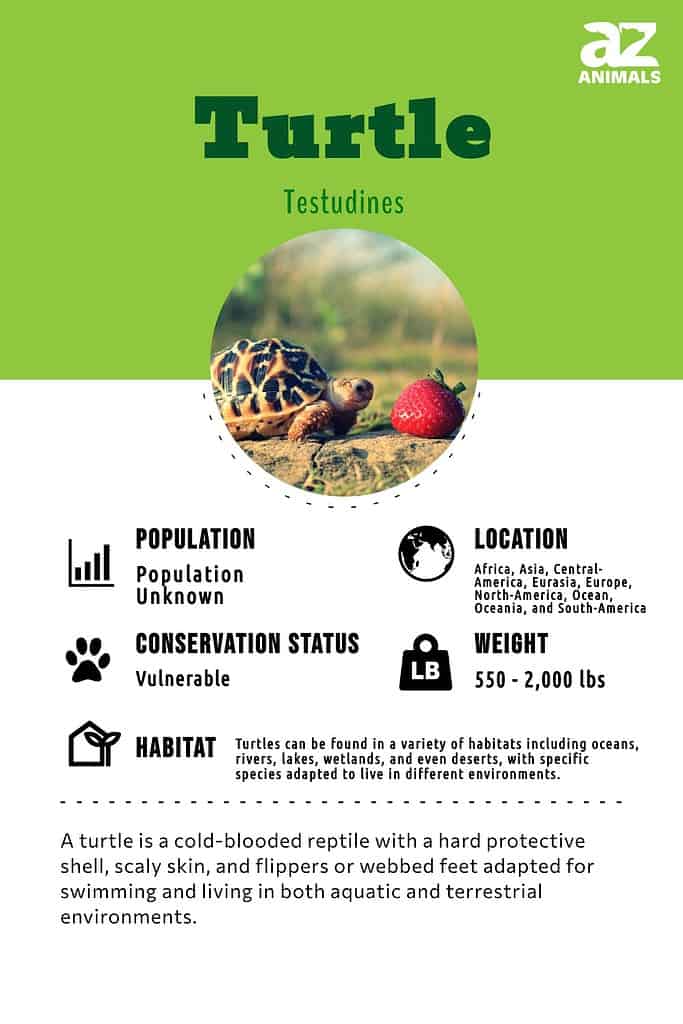
Over half of all turtle species are threatened by pollution and other human-caused issues.
Turtles are a broad group of animals, and they’ve existed on this earth for quite some time. There are over 300 different species, and each one has unique facts about its behaviors, diets, and appearances.
They can be found on land and in the sea, but more species are sea turtles. Unfortunately, that also means that more sea turtles are at risk of extinction.
4 Incredible Turtle Facts!
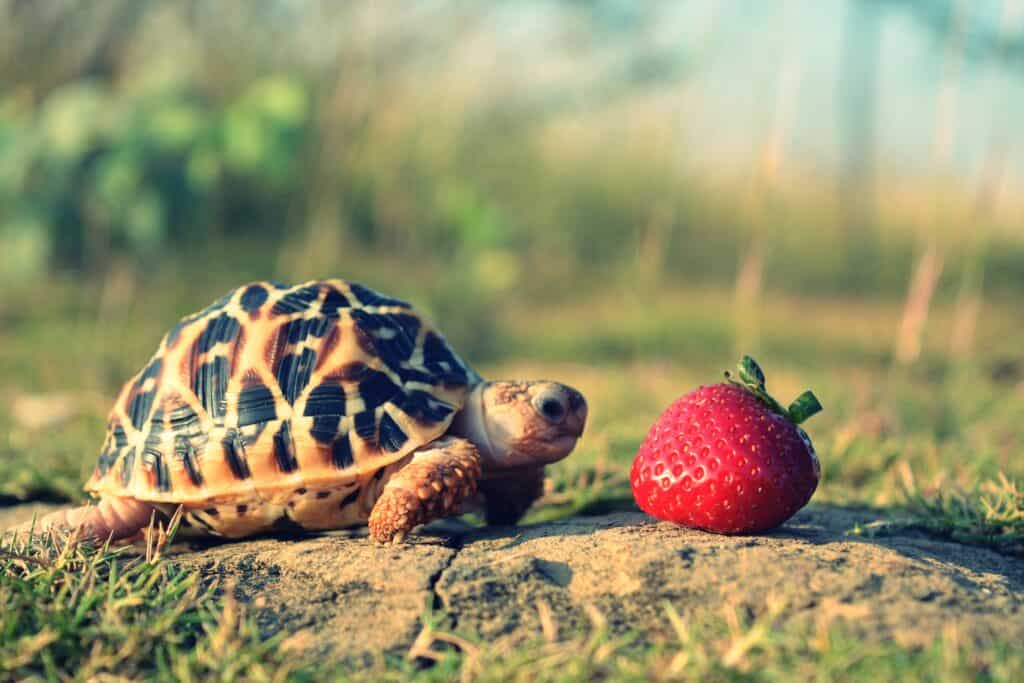
Turtles are opportunistic eaters.
©Hemant Singh/Shutterstock.com
Here are some fun turtle facts.
- Though many people use the phrases “tortoise” and “turtle” interchangeably, they are not the same animal.
- Turtles don’t participate in hibernation like other reptiles.
- Most sea turtles abandon their eggs on the shore, allowing them to hatch on their own before making their way to the ocean.
- The average pet turtle has a lifespan of nearly 80 years with the right care.
For more interesting facts, read “10 Incredible Turtle Facts.”
Turtle vs. Tortoise
These two animals are rather close together, but the facts show that they are much different. Tortoises have a much longer lifespan, which correlates with their large size.
Scientific Name
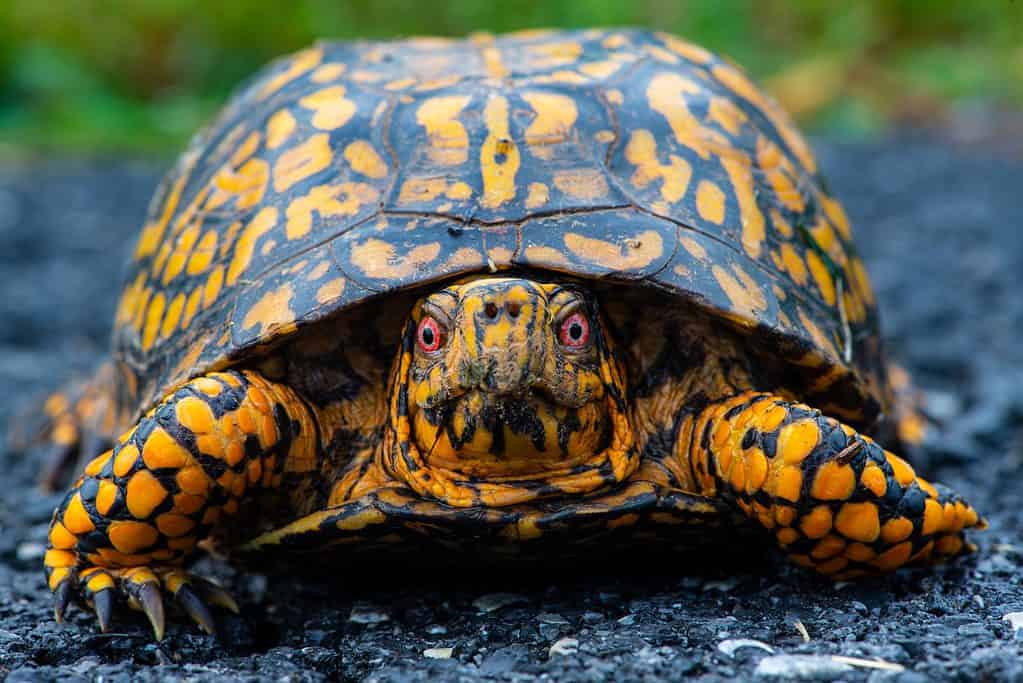
The box turtles of North America have dome-shaped shells which hinge at the bottom.
©RenEgAdeRooStEr/Shutterstock.com
The common name of the turtle is simply that – turtle. Their scientific name is Testudines, and the only other names that they go by are their particular species. Most of these animals are broken down simply into sea turtles and land-based turtles, though most land-based turtles are actually tortoises.
The turtle belongs to the Reptilia class in the Cheloniidae family, which primarily represents sea turtles. The word “Testudines” comes from the Latin word “testa,” which means “shell.”
Different Types
- Tortoise
- Sea turtles
- Red-eared slider
- Common snapping turtle
- Pond slider
- Box turtles
- Softshell turtles
- Painted turtle
- Chelidae
- Chinese pond turtle
- Common musk turtle
- D’Orbigny’s slider
- Chinese softshell turtle
- European pond turtle
- Eastern box turtle
- Japanese pond turtle
- Patagoniaemys
- Pond turtles
- Yellow-spotted river turtle
- Spotted turtle
- Chinese stripe-necked turtle
- Malayemys
- Trachemys callirostris
- Bog turtle
- Mexican musk turtle
- Sternotherus
- Razor-backed musk turtle
- Cryptodira
- Asian box turtle
- Pleurodira
- Cooters
- Mud turtles
- Yellow pond turtle
- Kinosternidae
- Carbonemys
- Pelomedusidae
- Spiny turtle
- Northern river terrapin
- Philippine forest turtle
- Black marsh turtle
- Black pond turtle
- Spanish pond turtle
- Painted wood turtle
- Thalassochelydia
- Liaochelys
- Larachelus
Evolution and Origins
The land-dwelling stem turtles began to live a semi-aquatic lifestyle around 110 million years ago, later developing into freshwater and saltwater turtle species that are entirely aquatic. The majority of these turtles would keep refining and simplifying the armor plating of their Proganochelys progenitor.
While some experts contend that turtles are more closely related to lizards and snakes than to lizards or snakes, others contend that turtles belong in the category of animals known as archosaurs, which also includes crocodiles, pterosaurs, dinosaurs, and birds.
The earliest known progenitor of contemporary turtles is a reptile called Eunotosaurus, which existed around 260 million years ago during the Permian epoch.
Appearance
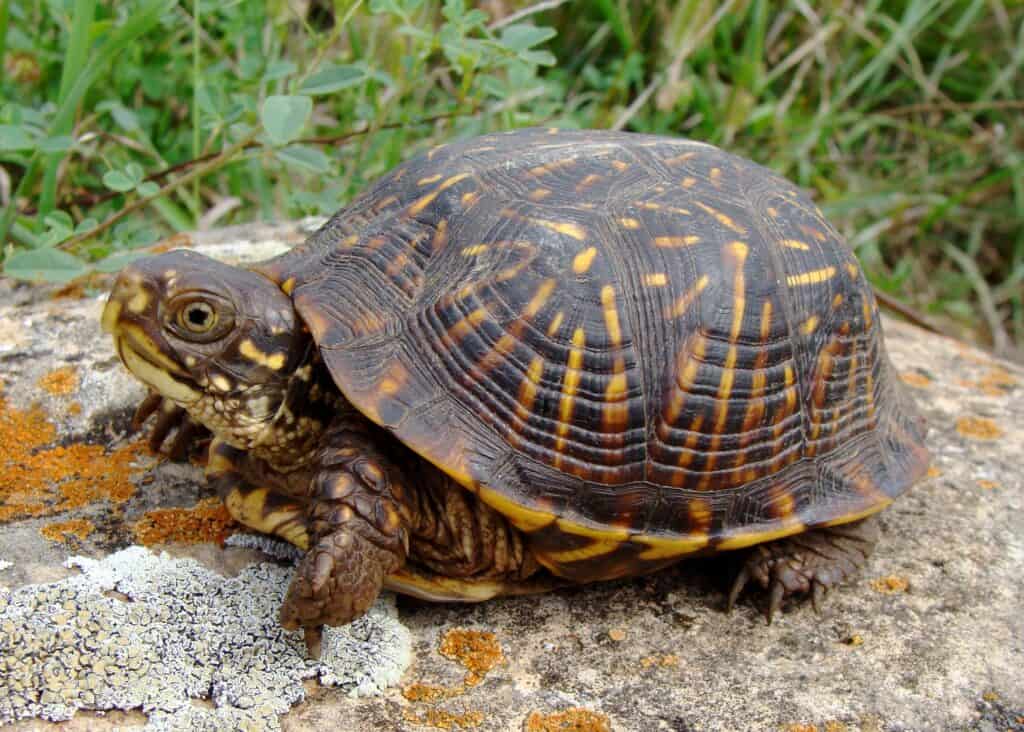
The ornate box turtle is only found in the United States.
©Matt Jeppson/Shutterstock.com
With over 300 different species to account for, it’s a bit difficult to determine what size you’re looking for. The size entirely depends on the species! For instance, if you have a pet turtle, it will likely reach no more than 4 to 12 inches. However, the largest turtle ever known was 15 feet long, measuring from his head to his tail. He even was 13 feet wide from one flipper to the other.
Considering the great range in size, the same is true of their weight. While the largest turtle weighed over 2,000 pounds, this animal can be anywhere in between. The sea turtle alone weighs about 420 lbs. when it is fully grown.
If you’re looking for a particular color for the turtle, you won’t be disappointed. They practically are found in every color under the sun. Most people imagine that they are green (like the green sea turtle), though they can also be brown or even black like the snapping turtle. The color is primarily determined by the area in which they live.
A group of turtles can be called many things, like a bale, a dole, or a nest of turtles.
Behavior
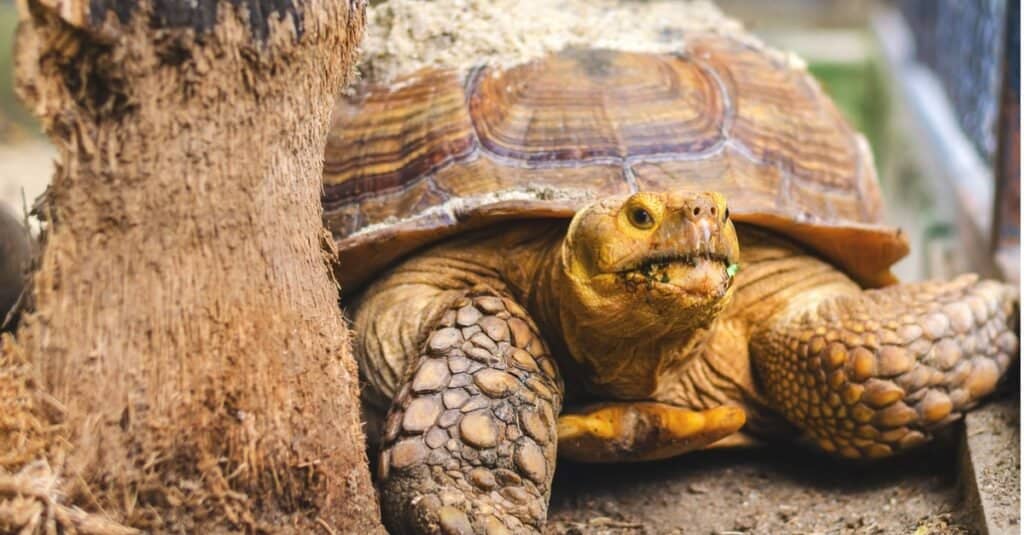
©Kitinut Jinapuck/Shutterstock.com
As much as the appearance varies from one species to the next, their behavior varies as well. Some species are solitary, while others prefer to live with a family for most of their life. The groups are called bales or dole, but their personality is where things greatly change.
Pet turtles are meant to be more friendly and docile unless threatened. In the ocean, the Red-Eared Slider is particularly friendly, which is a shared reputation among many sea turtles. The snapping turtle, however, is a different story.
Ultimately, researchers have found that the snapping turtle is not exactly as aggressive as one might think. Instead, they focus on defending themselves as much as they can when they are approached by a human. They spend their days waiting for their next meal, but getting bit is not worth risking.
Even though other reptiles have a time of hibernation, the same is not true of turtles. Their bodily processes slow, but hibernation does not settle in.
Habitat
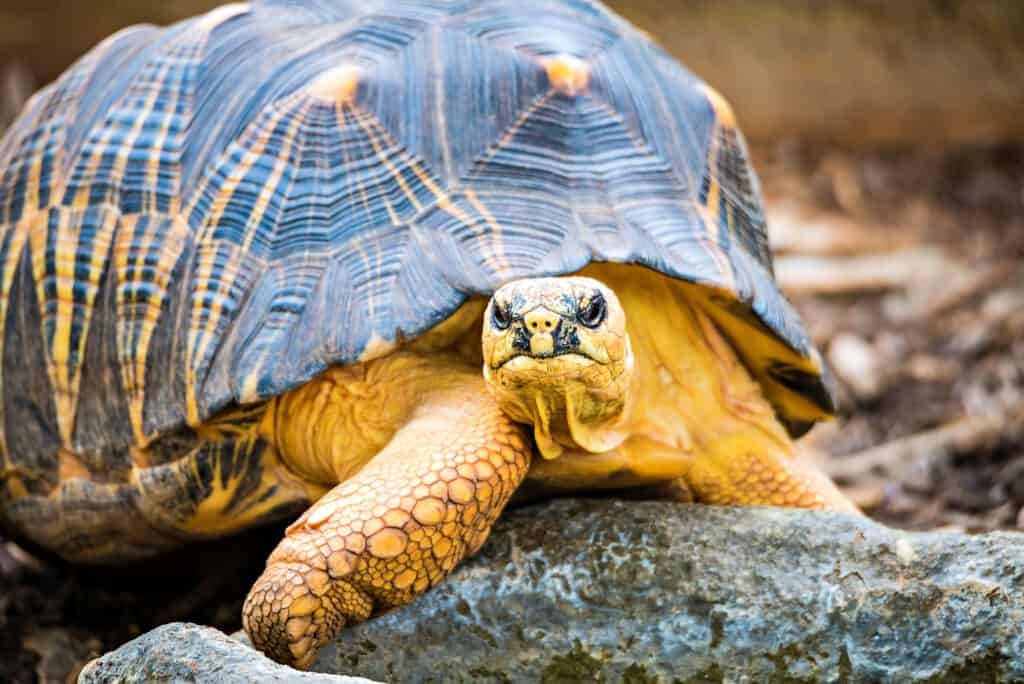
Turtles are found all over the world. They are incredibly adaptable to many different environments, living on land and in the sea.
©iStock.com/alex grichenko
Turtles are found all over the world. They are incredibly adaptable to many different environments, living on land and in the sea. Most commonly, these reptiles are found in southeastern North America and South Asia, though a shocking number of them are sea turtles.
To swim through the waters, they have flippers with incredible control over their direction and speed. They can even maintain a warm body temperature with their large bodies, and they stay warm with the extra fat that they carry.
Land-based turtles mostly have to rely on their behaviors to defend themselves. The shell is fused with its spine, and it is quite easy to damage without the right safe spot to hide.
Predators & Threats
The time in a turtle’s life that they are at the greatest peril is when they are young. Their shells are still quite soft, and they are on the menu for many predators – large and small. Turtles tend to graze on what they find, enjoying shrubs and fruits that they can get their mouths on. When available, they will also enjoy small insects.
Humans and pollution tend to be the biggest threats to any species.
What eats turtles?
Turtles aren’t part of the food chain for many animals, but it is easy for them to get caught up. In the ocean, sharks are a major threat, though killer whales will also go after them. As a baby, the turtle can be eaten by just about any animal, including dogs, seabirds, ghost crabs, and fish.
What do turtles eat?

Since the turtle has such a broad diet, it is easy for him to find something for his meals. Though most land turtles will eat the foliage nearby, they’ll also eat caterpillars and other invertebrates that can round out the protein that they need.
Reproduction, Babies, and Lifespan
The way that sea turtles and land-based turtles mate is a bit different. In the sea, the male approaches the female’s back while she is swimming, holding on with his claws. However, land-based turtles vary in their approach. Typically not mated for life, the species can be 5-10 years old before they are sexually mature enough to mate.
Since turtles are reptiles, they release eggs. Most sea turtles will lay their eggs on land and leave them behind, allowing their hatchlings to take care of themselves from birth. Other species will hold their eggs inside their body for up to two years before releasing them to hatch.
For the most part, these babies are called hatchlings. They are able to move and see within moments after they hatch, but they are quite weak. The sea turtles born on the beach and near water have to trek back to the water as quickly as possible to avoid the predators that are waiting to eat them.
The beach can be a dangerous place. They are out in the open until the sand meets the sea. Once they’ve left the beach, the turtles that show group behaviors will seek out a family, “adopting” a mother as their own in the sea.
The lifespan varies from one species to another. Even in captivity or as a pet, larger species can live for up to 100 years or more.
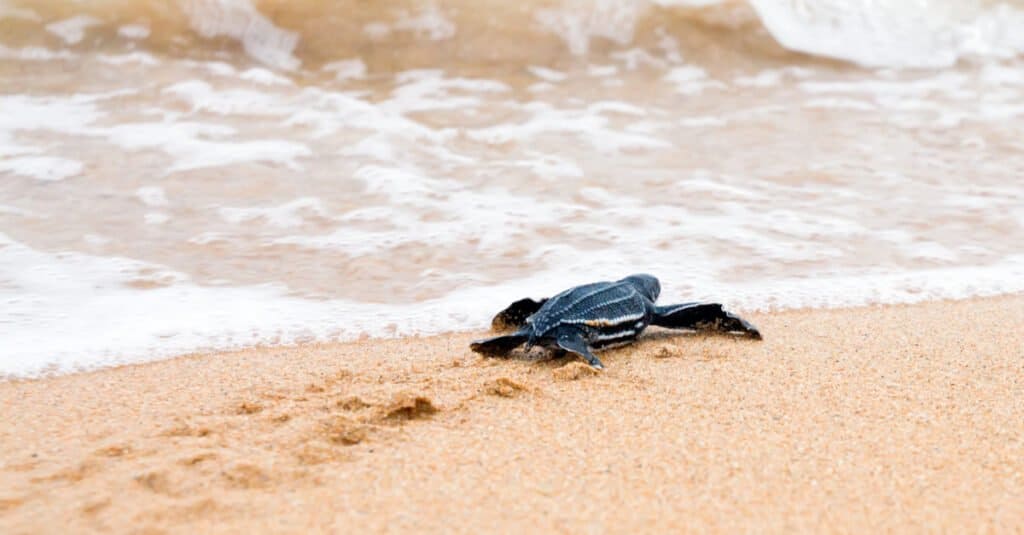
.
©IrinaK/Shutterstock.com
Population
Sea turtles alone account for 6.5 million of these reptiles in the while, though there are many species that are critically endangered. The numbers seem steady for many species of both land-based and sea-based turtles, but conservation efforts are still being made to reduce the pollution that can trap and kill so many species in the ocean.
The IUCN Red List of Threatened Species includes 187 different species of both turtles and tortoises that are currently threatened with extinction. The most endangered turtle species in the world is the Yangtze giant softshell turtle.
Turtles FAQs (Frequently Asked Questions)
Are turtles carnivores, herbivores, or omnivores?
Turtles are omnivores, consuming everything from seagrass and moss to shrimp and even other smaller turtles.
Is a turtle a good pet?
A turtle can be a very good pet but be warned they are marketed as low maintenance pets but there is a difference in care for water turtles and box turtles. In which water turtles are lower maintenance than box turtles, both still requiring regular tank cleaning and care.
Are turtles intelligent?
They are in fact much more intelligent than you would think, even smart enough to recognize their owners by sight and sound, all because of an instinctual intelligence.
What does a turtle eat?
Crabs, jellyfish, squid, shrimp, cuttlefish, sea cucumbers, sponges, algae, worms, snails, insect larvae, aquatic insects, crustaceans, water plants, frogs, snakes, fish, and smaller turtles are all part of a sea and box turtle diet.
How long can turtles live?
Turtles can live anywhere between 30 to 200+ years depending on species and environment.
Can a turtle fart?
Yes! They, in fact, do fart, and just like humans, their farts can range in sound and size with a very rank aroma because of their diet.
How do I take care of a turtle?
Taking care of a turtle can be rather challenging because of frequency but by task, it’s rather simple. First, you have to regularly monitor and clean its tank to keep a most ideal habitat at all times and leave room for basking when caring for a box turtle. Diet is an easy task to take on since they have so many different possible food options, just remember to take out old food and replace it often at regular feeding times. Everything else is as simple as any other pet.
How long does it take for turtle eggs to hatch?
Hatching turtle eggs takes anywhere from 40 to 75 days, depending on the species and environment.
Thank you for reading! Have some feedback for us? Contact the AZ Animals editorial team.
Sources
- Britannica, Available here: https://www.britannica.com/animal/turtle-reptile/Reproduction
- National Oceanic and Atmospheric Administration, Available here: https://oceanservice.noaa.gov/facts/leatherback.html
- Turtle Owner, Available here: https://turtleowner.com/how-fast-are-turtles/
- Turtle Pets, Available here: https://turtlepets.com/why-are-turtles-so-slow/
- The Nature Conservancy, Available here: https://www.nature.org/en-us/get-involved/how-to-help/animals-we-protect/leatherback-sea-turtle/
- Wikipedia, Available here: https://en.wikipedia.org/wiki/Chersobius_signatus
- Tortoise Expert, Available here: https://tortoiseexpert.com/which-tortoises-have-the-longest-lifespan-and-which-have-the-shortest/
- Cool Pets Advice, Available here: https://coolpetsadvice.com/tortoise-lifespan/
- Live Science, Available here: https://www.livescience.com/45539-what-do-turtles-eat.html
- Wildlife Informer, Available here: https://wildlifeinformer.com/do-turtles-breathe-out-of-their-butts/
- Infinite Spider, Available here: https://infinitespider.com/can-turtles-breathe-butts/
- Sea Turtle Status, Available here: https://www.seaturtlestatus.org/threats-to-turtles
- Mom.com, Available here: https://animals.mom.com/gestation-period-turtle-eggs-7009.html
- Conservation and Trade Management of Freshwater and Terrestrial Turtles in the United States , Available here: https://www.fws.gov/international/pdf/archive/workshop-terrestrial-turtles-presentation-abstracts.pdf

















